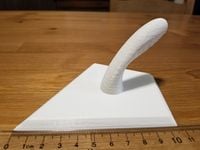| Line 3: | Line 3: | ||
Project developed by [[User:Agbretz|Agbretz]] ([[User talk:Agbretz|talk]]) 02:42, 5 December 2019 (UTC) | Project developed by [[User:Agbretz|Agbretz]] ([[User talk:Agbretz|talk]]) 02:42, 5 December 2019 (UTC) | ||
{{Statusboxtop}} | {{Statusboxtop}} | ||
{{status-prototype}} | {{status-prototype}} | ||
You can help Appropedia by contributing to the next step in this [[OSAT]]'s [[:Category:Status|status]]. | You can help Appropedia by contributing to the next step in this [[OSAT]]'s [[:Category:Status|status]]. | ||
Revision as of 05:34, 5 December 2019
Project Title
Project developed by Agbretz (talk) 02:42, 5 December 2019 (UTC)
Template:Statusboxtop Template:Status-prototype You can help Appropedia by contributing to the next step in this OSAT's status. Template:Boxbottom
Abstract
A pointer trowel is used in masonry to fill in joints. It has an angled, pointed end that can be used to get mortar into tight spaces. This tool was designed with appropriate technology in mind. The trowel is a simple design that can be easily changed through it's FreeCAD file and it is designed to be printed without the use of support material to save plastic. Many forms of building construction require the use trowels, whether it is in adding mortar between bricks or grout between tiles. Since many buildings in third world countries are made in a masonry style, this tool would be very useful and cost efficient for those who would need it.

Bill of Materials
- Provide a full BOM -- Materials needed for fabrication of device and alternative materials if they are not available, prices/sources of non-printable parts
- Upload and link to all source files from open source CAD
- Upload and link to all STLs
Tools needed for fabrication of the OSAT
- MOST Delta RepRap or similar RepRap 3-D printer
Skills and Knowledge Necessary to Make the OSAT
- If you used special skill – link to relevant Wikipedia or Wikiversity articles/courses
Technical Specifications and Assembly Instructions
- Provide directions for print/assembly - be detailed enough in your “how to” to ensure that someone could construct the device from your description. Consider the elegance of IKEA like instructions.
- Include print time estimate
- Include assembly time estimate
- Including drawings or pictures of the device at stage of assembly at minimum. (http://www.appropedia.org/Special:Upload)
- Consider video if appropriate
| Example video summary of textbook |
|---|
Error in widget YouTube: Unable to load template 'wiki:YouTube' |
Common Problems and Solutions
- Include common mistakes/problems to avoid in building your OSAT and how to overcome them
Cost savings
- If your solution is not a low cost one then it is not really appropriate.
- Estimate your costs
- Find a commercial equivalent, cite it and put the [url in square brackets]
- Calculate $ savings and % savings
Benefited Internet Communities
- Name and add links to at least 5 using single brackets around [url name]
References
- The sources of information (e.g. engineering handbooks, journal articles, government documents, webpages, books, magazine articles etc.). References should use the <ref> </ref> and <references/> tags and can be in any format but should include all the information necessary for someone else to find the same information you did. For example: [1]
- ↑ web page: Department of Energy (DOE) Landscaping and Energy Efficiency, DOE/GO-10095 (1995) Available: http://www.eren.doe.gov/erec/factsheets/landscape.html
Based on the developmental needs addressed (e.g. food, heat, electricity, clean water, health care, etc.) be sure to label your device in the proper categories e.g. use [[Category:Water]]. Be sure to categorize your device so that it will be easy to find – for example “Low voltage connection basics” is categorized in [[Category:How tos]] [[Category:Electricity]] [[Category:Electric lighting]].